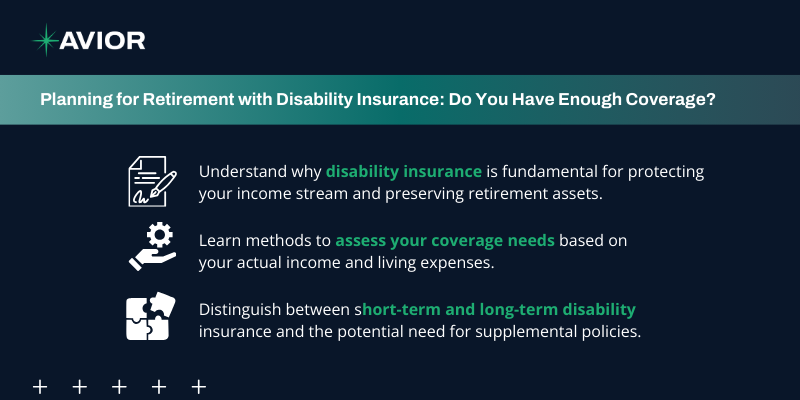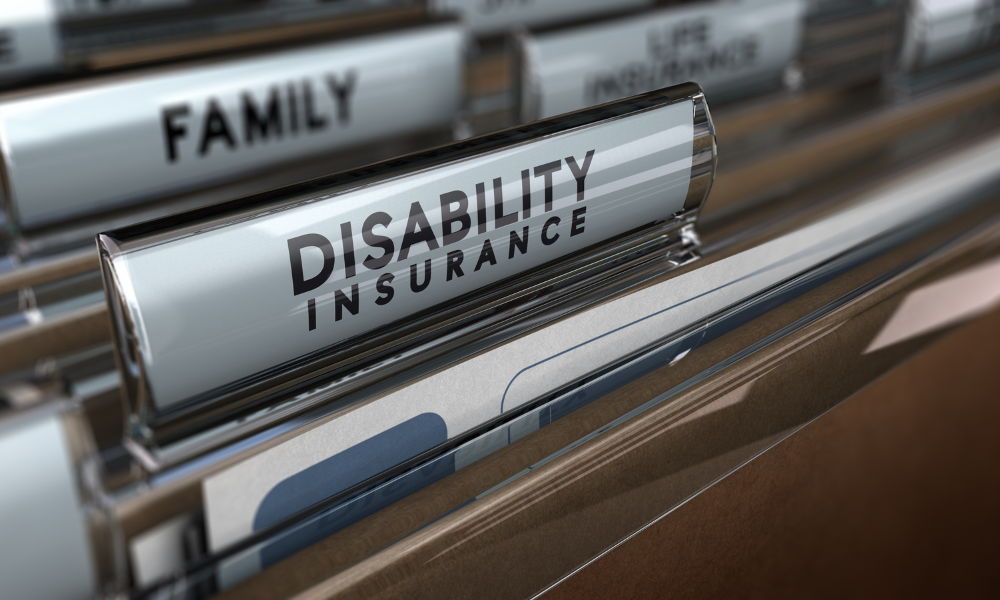Planning for Retirement with Disability Insurance: Do You Have Enough Coverage?

Mapping out your retirement involves careful consideration of savings, investments, and future income needs. However, a comprehensive plan also accounts for the unexpected. What happens to your retirement goals if an illness or injury sidelines you from your career? Disability insurance (DI) plays a vital role in protecting your financial well-being and preserving your long-term objectives by addressing your most significant financial asset: your ability to earn income.
Key Takeaways:
- Understand why disability insurance is fundamental for protecting your income stream and preserving retirement assets.
- Learn methods to assess your coverage needs based on your actual income and living expenses.
- Distinguish between short-term and long-term disability insurance and the potential need for supplemental policies.
- Recognize the importance of reviewing policy details like benefit periods, waiting periods, definitions of disability, and riders like COLA.
- See how integrating disability insurance contributes to a more resilient financial foundation.
The Role of Disability Insurance in Retirement Planning
Your capacity to work and generate income underpins both your current lifestyle and your ability to build retirement savings. A disability can disrupt this foundation in ways many don’t anticipate.
- Impact on Retirement Savings: Without an income replacement strategy, you might have little choice but to withdraw funds from your 401(k) or IRA prematurely. This not only diminishes the pool of assets intended for your later years but can also trigger early withdrawal penalties and taxes, setting back your progress. Furthermore, your ability to make ongoing contributions halts, reducing the potential for future growth.
- Covering Ongoing Financial Obligations: Disability insurance provides a replacement income stream, helping you manage essential living expenses—such as mortgage or rent payments, utilities, healthcare costs, and loan installments—without depleting your long-term savings or investments.
- Mitigating Financial Strain: Knowing you have a source of replacement income can alleviate significant financial stress during an already challenging period, allowing you to concentrate on your health and recovery.
Calculating Your Coverage Needs
Determining the appropriate amount of disability coverage requires a realistic look at your finances:
- Analyze Your Expenses: Tally your necessary monthly outflows. Include housing, food, transportation, insurance premiums (health, life, auto, home), utilities, debt payments, and other recurring costs. Consider potential increases in medical expenses related to a disability.
- Factor Your Income: Note your current gross (pre-tax) and net (take-home) pay.
- Consider Other Resources: Account for emergency savings, investments you could potentially liquidate (though ideally avoided), and income from a spouse or other household members.
Disability insurance policies replace a percentage of your pre-tax income, commonly between 40% and 80%. A target of 60-70% is often recommended.
Most financial experts recommend aiming for disability coverage that replaces 60-70% of your pre-tax income. This lower-than-100% figure makes sense for several reasons: benefits from individual policies are often received income-tax-free (if premiums were paid with after-tax dollars), and certain work-related expenses like commuting costs or professional wardrobes may decrease when you’re not actively working.
The ultimate goal is to cover your essential living costs and maintain your financial stability, not necessarily to match your working income.
Understanding Different Types of Disability Insurance
Short-Term Disability (STD): Often provided by employers, these policies cover periods ranging from a few weeks up to several months. They’re designed to bridge temporary gaps when you’re unable to work due to less severe injuries, surgeries, or short-term illnesses. While valuable, they rarely provide enough protection for serious disabilities.
Long-Term Disability (LTD): This is the cornerstone for protecting your retirement plans. LTD policies provide income replacement for extended durations—often years, or potentially until retirement age—if an illness or injury prevents you from working. While employers might offer group LTD, the coverage amount or benefit period may be limited compared to what you actually need.
Individual/Supplemental Policies: If your employer-provided coverage falls short of your calculated needs (perhaps covering only a base salary percentage or having a shorter benefit period), obtaining a private, individual LTD policy can fill the gap. These policies offer personalized protection tailored to your specific income situation and financial needs, with the added advantage of staying with you regardless of job changes.
Is Your Current Policy Adequate? Key Details to Review
Many people assume they have adequate disability coverage through work without examining the details. Take time to review these critical policy elements:
- Benefit Amount: Check exactly how much income your policy replaces, either as a dollar amount or percentage of income. Remember that group policies often cap benefits at a certain level, which might fall short for higher earners.
- Benefit Period: How long will payments continue if you remain disabled? Options range from 2 years, 5 years, to age 65 or your full retirement age. Longer benefit periods provide stronger retirement protection but cost more.
- Waiting Period (Elimination Period): This is how long you must be disabled before benefits begin—30, 90, or 180 days. Your emergency fund should be sufficient to cover expenses during this gap.
- Definition of Disability: This seemingly technical detail affects your protection. An “own-occupation” definition pays if you can’t perform your specific job, while an “any-occupation” definition pays if you can’t perform any job for which you’re reasonably suited. The former offers much broader protection for specialized professionals.
- Riders and Enhancements: Look for valuable additions like Cost-of-Living Adjustment (COLA) riders that increase benefits over time to counter inflation, or residual/partial disability benefits that provide some income if you can work part-time.
- Coordination with Social Security: Understand how your policy works alongside potential Social Security Disability Insurance (SSDI) benefits. While SSDI can provide additional support, it has strict eligibility requirements and often provides modest benefits compared to your actual income.
Building a Resilient Financial Future
Effectively weaving disability insurance into your financial plan involves ongoing attention:
- Periodic Reviews: As your income, expenses, or family situation changes, revisit your disability coverage to confirm it remains aligned with your needs.
- Sufficient Emergency Fund: Maintain readily accessible savings to manage expenses during the policy’s waiting period.
- Integrated Financial Planning: Disability insurance shouldn’t exist in a vacuum. It works best as part of a holistic financial plan.
Protecting your income stream is a fundamental part of preparing for your financial future. Addressing this potential vulnerability through thoughtful planning strengthens your ability to navigate life’s uncertainties and pursue your long-term goals.
Work With Us
At Avior, helping you plan with intention is what we do, but helping you live with purpose is who we are. Evaluating and integrating appropriate disability insurance is a key component of comprehensive financial planning. We can assist you in assessing your needs, understanding your current coverage, and exploring strategies to build a robust financial foundation tailored to your life.
Contact Avior today to schedule a consultation. Together, we can chart a course toward your financial objectives.
Disclaimer: Nothing contained herein should be construed as legal or tax advice. Avior and our Advisors will work with your attorney and/or tax professional to assist with your legal and tax strategies. Please consult your attorney or tax professional with specific legal and/or tax questions. Investment Management and Financial Planner are offered through Avior Wealth Management, LLC, an SEC-registered investment advisor. Past performance is not a guarantee of future results. Investments are subject to loss, including the loss of principal.
No Comments
Sorry, the comment form is closed at this time.




